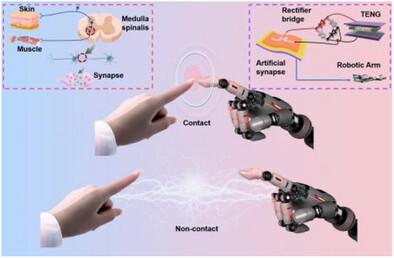当前位置:
X-MOL 学术
›
Small Methods
›
论文详情
Our official English website, www.x-mol.net, welcomes your feedback! (Note: you will need to create a separate account there.)
Dual Interactive Mode Human–Machine Interfaces Based on Triboelectric Nanogenerator and IGZO/In2O3 Heterojunction Synaptic Transistor
Small Methods ( IF 12.4 ) Pub Date : 2024-04-12 , DOI: 10.1002/smtd.202301698 Yashuai Qi 1 , Jing Tang 2 , Shuangqing Fan 1 , Chunhua An 3 , Enxiu Wu 3 , Jing liu 3
Small Methods ( IF 12.4 ) Pub Date : 2024-04-12 , DOI: 10.1002/smtd.202301698 Yashuai Qi 1 , Jing Tang 2 , Shuangqing Fan 1 , Chunhua An 3 , Enxiu Wu 3 , Jing liu 3
Affiliation

|
Imitating human neural networks via bio‐inspired electronics advances human‐machine interfaces (HMI), overcoming von Neumann limitations and enabling efficient, low‐energy data processing in the big data era. However, single‐contact mode HMIs have inherent limitations in terms of their capabilities and performances, such as constrained adaptability to dynamic environments, and reduced cognitive processing capabilities. Here, a dual‐interactive‐mode HMI system based on a triboelectric nanogenerator (TENG) and heterojunction synaptic transistor (HJST) is proposed for both contact and non‐contact applications. The TENG incorporates a poly‐methyl meth‐acrylate (PMMA)‐NiCo2 S4 /S film, in which the NiCo2 S4 /S composite traps and blocks electrons to optimize charge generation and storage. The heterojunction structure, mitigates the Debye screening effect, thereby improving transistor characteristics and reliability. The integrated TENG‐HJST system exhibits synaptic functions, including excitatory/inhibitory postsynaptic current (EPSC/IPSC), paired‐pulse facilitation/depression (PPF/PPD), and synaptic plasticity, enabling emulation of neural behavior and advanced information processing. Moreover, neural morphology manipulation is demonstrated in practical tasks, such as controlling international chess games. By integrating the TENG‐HJST device with a robotic hand, conscious artificial responses are generated, enhancing event accuracy. This breakthrough in dual‐interactive‐mode interfacing holds promise for HMI systems and neural prostheses.
中文翻译:

基于摩擦纳米发电机和IGZO/In2O3异质结突触晶体管的双交互模式人机界面
通过仿生电子学模拟人类神经网络可以推进人机界面 (HMI),克服冯·诺依曼的局限性,并在大数据时代实现高效、低能耗的数据处理。然而,单接触模式HMI在功能和性能方面存在固有的局限性,例如对动态环境的适应性有限,认知处理能力下降。这里,提出了一种基于摩擦纳米发电机(TENG)和异质结突触晶体管(HJST)的双交互模式HMI系统,适用于接触式和非接触式应用。 TENG 采用聚甲基丙烯酸甲酯 (PMMA)-NiCo2 S4 /S 薄膜,其中 NiCo2 S4 /S 复合材料捕获并阻挡电子以优化电荷生成和存储。异质结结构减轻了德拜屏蔽效应,从而提高了晶体管特性和可靠性。集成的 TENG-HJST 系统表现出突触功能,包括兴奋性/抑制性突触后电流 (EPSC/IPSC)、配对脉冲促进/抑制 (PPF/PPD) 和突触可塑性,从而能够模拟神经行为和高级信息处理。此外,神经形态操纵在实际任务中得到了证明,例如控制国际象棋比赛。通过将 TENG-HJST 设备与机械手集成,可以产生有意识的人工反应,从而提高事件的准确性。双交互模式接口的这一突破为 HMI 系统和神经假体带来了希望。
更新日期:2024-04-12
中文翻译:

基于摩擦纳米发电机和IGZO/In2O3异质结突触晶体管的双交互模式人机界面
通过仿生电子学模拟人类神经网络可以推进人机界面 (HMI),克服冯·诺依曼的局限性,并在大数据时代实现高效、低能耗的数据处理。然而,单接触模式HMI在功能和性能方面存在固有的局限性,例如对动态环境的适应性有限,认知处理能力下降。这里,提出了一种基于摩擦纳米发电机(TENG)和异质结突触晶体管(HJST)的双交互模式HMI系统,适用于接触式和非接触式应用。 TENG 采用聚甲基丙烯酸甲酯 (PMMA)-NiCo



























 京公网安备 11010802027423号
京公网安备 11010802027423号